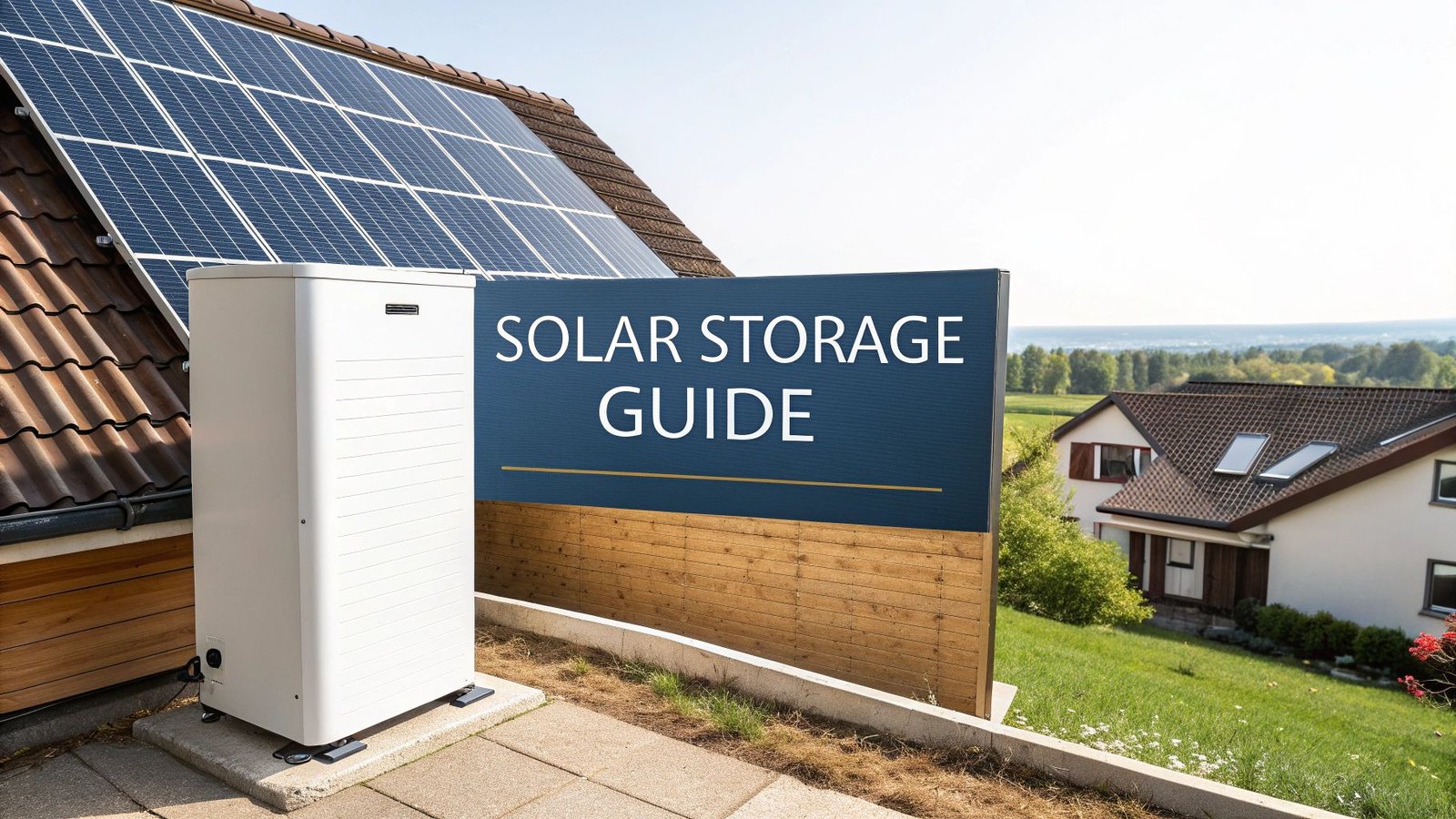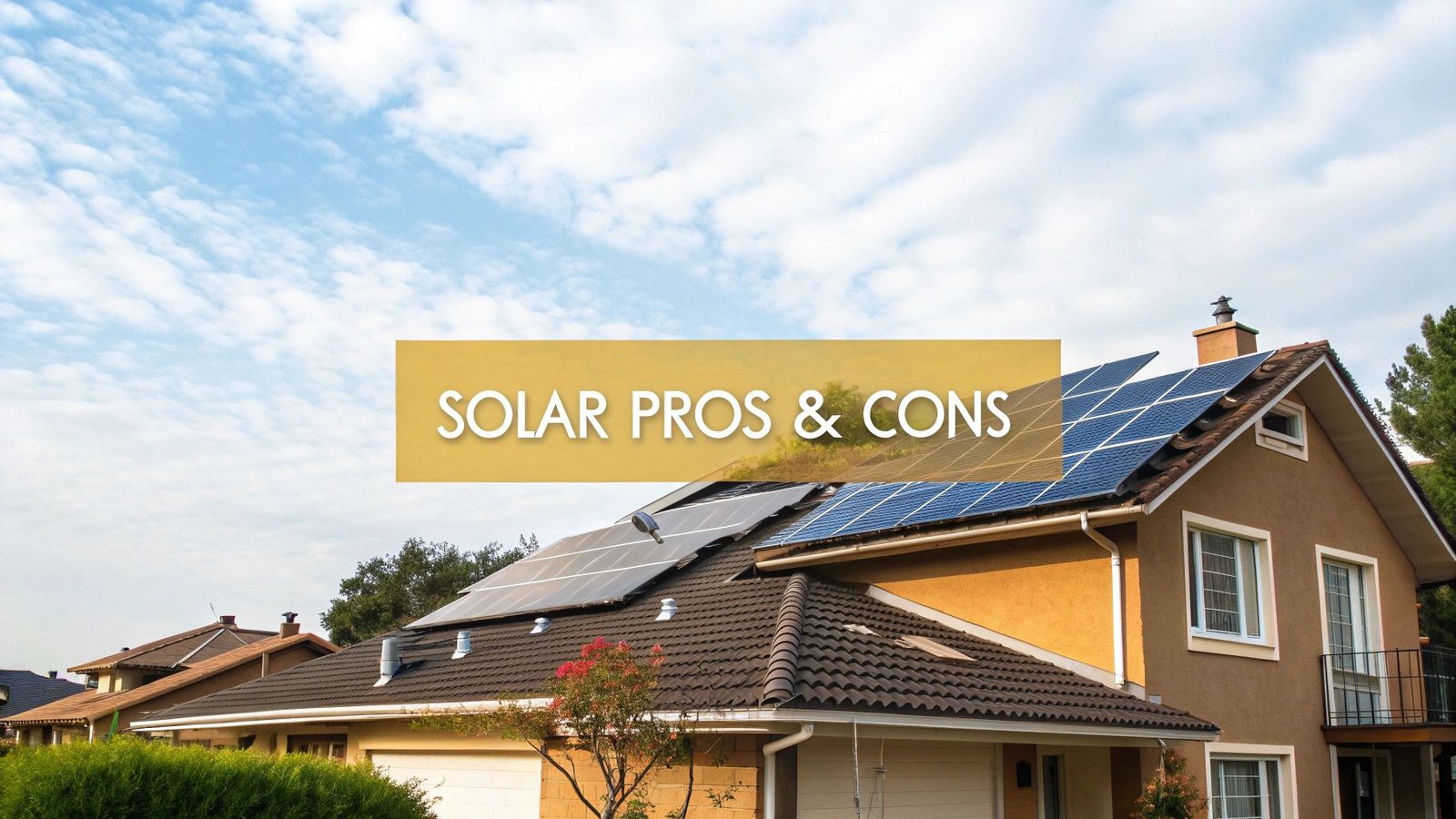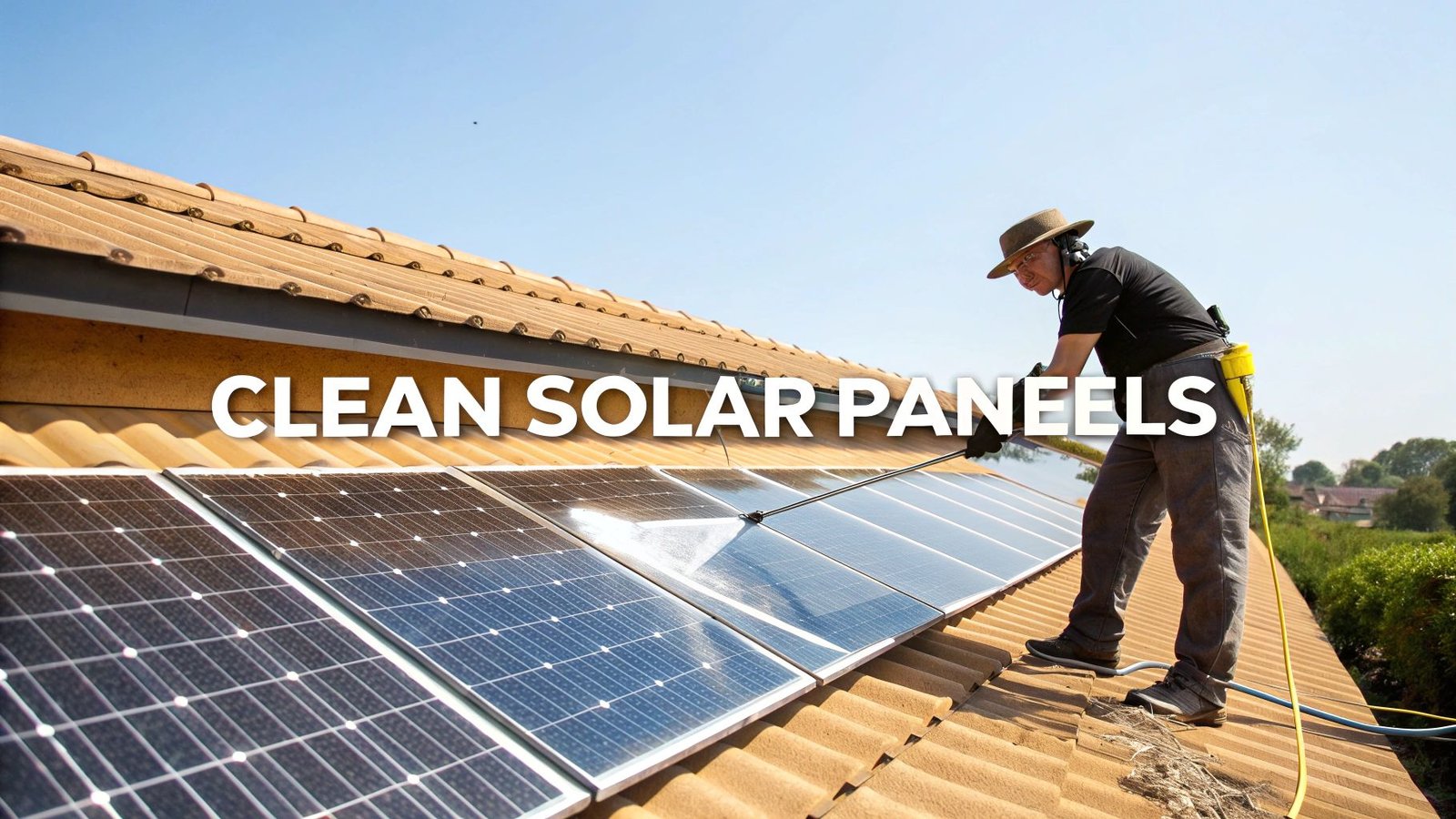Getting the size of your solar system right is crucial. It’s a balancing act: you want enough power to meet your needs without sinking money into panels you don't actually need. The basic math is pretty straightforward: figure out your daily energy use in kilowatt-hours (kWh), divide that by the amount of direct sunlight your area gets, and then account for the real-world inefficiencies that every system has.
Your Starting Point for Solar Sizing
Figuring out how to size a solar system can feel a bit daunting at first, but it really just boils down to understanding your own energy habits. Think of it less like an engineering problem and more like creating a personalized energy budget. This guide will walk you through it, piece by piece.

First, we'll dig into your electricity bills to get a clear picture of how much energy your home actually consumes day-to-day. After that, we’ll look at how your specific location impacts production using something called horas punta de sol. Finally, we'll factor in the inevitable energy losses that happen in any solar setup to make sure your array delivers the power you expect it to.
Key Factors in Sizing
This part will give you a solid foundation, so you know exactly what information to gather and why it matters so much. There are really three core things you need to nail down:
- Your Energy Consumption: How much electricity does your household really use every day?
- Your Location's Sunlight: How many hours of usable, strong sunlight does your roof actually get?
- System Inefficiencies: How much energy naturally gets lost when converting sunlight into usable AC power for your home?
It’s also smart to think about the bigger picture. When you're planning a project like this, it helps to be aware of local sustainability frameworks, such as the Dubai Green Building Regulations. This ensures your system not only meets your personal goals but also aligns with broader community efforts. Getting these concepts down is the first real step toward designing a system that will pay for itself.
Sizing Up Your Home's Energy Needs
Before you can even think about solar panels, you need to know exactly how much power your home actually uses. The best place to find this information is on your electricity bill. It's the key to understanding your home's energy appetite, specifically the total kilovatios-hora (kWh) you consume.

To get the full picture, you’ll want to grab the last 12 months of your utility statements. Most bills conveniently include a chart showing your usage history, which is perfect for seeing those seasonal spikes—like when the air conditioner runs non-stop all summer.
Once you have the bills, just add up the total kWh for the entire year and divide that number by 365. This will give you a solid average of your daily energy consumption.
Let’s walk through a quick example:
- You used 10,950 kWh over the last year.
- Divide that by 365 days: 10,950 kWh / 365 = 30 kWh per day.
- This 30 kWh is the daily energy target your new solar system needs to hit.
Don't Forget to Plan for the Future
Sizing a system for your needs today is smart, but sizing it for your needs tomorrow is even smarter. Are you thinking about buying an electric vehicle in the next few years? What about installing a new heat pump or a hot tub? These kinds of upgrades will definitely increase your electricity demand.
For instance, if you're considering an EV, knowing how to charge an electric vehicle is a crucial first step in estimating just how much your future consumption will jump.
The chart below shows how different future additions can impact your daily electricity usage.
| Future Upgrade | Estimated Daily kWh Increase |
|---|---|
| Electric Vehicle | 10 – 15 kWh |
| Hot Tub / Spa | 8 – 12 kWh |
| Central Air Conditioning | 20 – 25 kWh |
| Electric Heat Pump | 15 – 20 kWh |
A good rule of thumb I always recommend is to add a buffer of 10-25% to your current usage. This little bit of foresight ensures your solar investment continues to pay off for years to come and saves you from the expensive headache of adding more panels later.
If you want to dive deeper into the specifics, our guide on https://radiantenergysolar.com/how-to-calculate-solar-panel-needs/ breaks it down even further.
Finding Your Location's Solar Potential
Once you’ve figured out how much energy your home uses, the next piece of the puzzle is to see how much sunshine your specific location actually gets. It's no secret that a solar panel in Phoenix will crank out a lot more power than the exact same panel in Seattle. This all boils down to a key metric called horas punta de sol.
This isn't just a count of daylight hours. Peak sun hours measure the intensity of sunlight—the time when the sun is strong enough to deliver 1,000 watts of energy per square meter. Think of it as the number of hours your panels are working at maximum capacity.
What Are Peak Sun Hours?
Figuring out the average peak sun hours for your zip code is absolutely essential. You can’t size a system properly without it. Luckily, there are plenty of online tools and solar calculators that give you this data, so you don't have to guess. This number is what we'll use to determine how many panels you truly need.
Simply put, more peak sun hours means each panel produces more electricity, so you might get away with a smaller system. Fewer sun hours? You’ll need a larger array to hit the same energy goals.
To give you a real-world idea of how much this varies, take a look at the differences across the country. This is why a one-size-fits-all solar solution just doesn't exist.
Average Daily Peak Sun Hours by Location
This chart shows how geography impacts solar production. A higher number means more energy can be generated per solar panel.
| City/Region | Average Daily Peak Sun Hours |
|---|---|
| Phoenix, AZ | 6.5 – 7.5 |
| Miami, FL | 5.0 – 5.5 |
| Denver, CO | 5.5 – 6.0 |
| Boston, MA | 4.0 – 4.5 |
| Seattle, WA | 3.5 – 4.0 |
As you can see, a homeowner in Arizona has a significant advantage over someone in Washington state, and their system designs will reflect that.
Don't Forget Real-World Factors
Peak sun hours give you a great baseline, but what happens on your actual roof is just as important. The two biggest things to watch out for are your roof’s orientation and any potential shading.
- Roof Direction: For those of us in the Northern Hemisphere, a south-facing roof is the gold standard. It gets the most direct sunlight throughout the day.
- Shading: That big, beautiful oak tree in your yard? It could be a solar killer. Trees, chimneys, and even a neighbor’s second-story addition can cast shadows that will seriously cut into your energy production.
This is exactly why installers map out a roof to find the best spots for panels, working around any obstructions.

Every roof is different, and a professional site assessment is the only way to account for all these unique variables. It ensures your system is sized correctly and will perform the way you expect it to for years to come.
Accounting for Real-World Performance and Choosing Your Panels
Now that you have your ideal system size on paper, it's time for a reality check. Every solar installer knows that a system's lab-rated power and its real-world output are two different things. No solar setup is ever 100% efficient.
The journey from sunlight hitting your roof to powering your toaster involves tiny energy losses at every step. This is a completely normal part of how solar works, and we plan for it using something called a derate factor.
Why Your System Won't Be 100% Efficient
Think of the derate factor as a built-in buffer. It accounts for all the little things that chip away at performance:
- Heat from the sun slightly reducing panel output.
- A thin layer of dust or pollen on the glass.
- Minor resistance in the wiring.
- The inverter's process of converting DC power to usable AC power.
A conservative, industry-standard derate factor is 0.80. This means you can realistically expect your system to deliver about 80% of its "perfect conditions" rating. So, to ensure you meet your energy goals, we need to size up the system to compensate.
If our initial math pointed to a 5 kW system, we'd adjust it for the real world like this:
5 kW / 0.80 (derate factor) = 6.25 kW
That 6.25 kW figure is the actual system size you should aim for. It's the secret to building a system that doesn't underperform when you need it most.
Picking the Right Solar Panels
With a realistic target of 6.25 kW in mind, we can move on to selecting the actual hardware. You'll mainly see two types of panels on the market: monocristalino y policristalino. Monocrystalline panels are a bit more efficient and handle high temperatures better, making them a premium choice, though they cost a little more. For a full breakdown, our guide on cómo elegir paneles solares es un gran recurso.
The panel's wattage rating is also crucial. Modern panels typically fall between 300 to 450 watts. The higher the wattage, the more power each panel produces, which means you need fewer of them to hit your target. This is a game-changer if you have limited roof space.
Let's put it into practice.
To build that 6.25 kW (or 6,250 watt) system, here's how the math plays out:
- With 350W panels, you’d need: 6,250 / 350 = 18 panels (approximately)
- With more powerful 425W panels, you’d need: 6,250 / 425 = 15 panels (approximately)
It’s always fascinating to see how local climate dictates system size. In the UK, a typical home might get by with a 3 to 4 kW system. But in a sun-drenched place like Australia, it’s common to see systems ranging from 5 to 10 kW. You can explore more of these global solar statistics on Greenmatch.co.uk to see how your needs compare. It just goes to show that where you live is one of the biggest factors in sizing a solar system.
How to Size Your Solar Battery Storage
A solar battery is your ticket to true energy independence, keeping the lights on during grid outages and long after sunset. But getting the size right is crucial. It’s not about buying the biggest battery you can find; it’s about carefully matching its capacity to what you genuinely need for security and peace of mind.
The first question I always ask homeowners is, "How many cloudy days in a row do you want to be prepared for?" This is what we call your desired days of autonomy. For most residential setups, planning for one or two days without sun is a solid, practical starting point that balances cost and resilience.
Defining Your Critical Loads
Next, we need to figure out what absolutely must stay on during an outage. These are your "critical loads"—the essential appliances you simply can't live without. Take a moment and walk through your home, thinking about what's truly necessary for your family's safety and comfort.
This chart illustrates a sample breakdown of critical loads versus non-essential loads.
| Appliance Category | Example Items | Daily kWh (Approx.) |
|---|---|---|
| Critical Loads | Refrigerator, Key Lights, Internet, Well Pump | 8 – 12 kWh |
| Non-Essential Loads | Air Conditioner, TV, Washer/Dryer, Oven | 20 – 30+ kWh |
The goal here isn't to power your entire house like normal. It's about maintaining the essentials. Once you have that list, add up their daily energy consumption (in kWh) to get your critical load demand.
A common mistake I see is people oversizing their battery to run non-essential luxuries. This inflates the cost dramatically. My advice? Focus on resilience first. Powering the big-screen TV can wait until the grid is back up.
Understanding Battery Specifications
Finally, you'll come across a term called depth of discharge (DoD). This is a big one. It's the percentage of a battery's total capacity that you can safely use without damaging it and shortening its lifespan.
For instance, a 10 kWh battery with a 90% DoD gives you 9 kWh of actual, usable energy. A lower-quality battery might have a lower DoD, which means you get less bang for your buck.
As you plan your system, knowing what affects battery health is key to making a smart investment. Reading up on maximizing your solar battery lifespan will pay dividends down the road. For a closer look at the different technologies available, you can learn more about how to store solar energy en nuestra guía detallada.
Tying Up Loose Ends: Common Solar Sizing Questions
Even after you've run the numbers, a few questions are bound to pop up. That’s completely normal. Let's walk through some of the most frequent questions I hear from homeowners, so you can move forward with your solar project feeling confident.
What Happens If I Get the Size Wrong?
This is a big one, and for good reason. Nailing the right size is crucial for getting the most out of your investment.
If you go too small, you'll likely feel a bit let down. An undersized system means you're still pulling a lot of power from the grid, and your utility bills won't drop as much as you'd hoped. It’s a common mistake that can make your whole solar project feel like it fell short.
But going too big isn't necessarily better. Oversizing can mean you’re paying for panels and generating power you can't use or sell back effectively. If your utility offers poor buy-back rates for the surplus energy you generate, you've essentially just spent extra money for a minimal return. The goal is to find that perfect balance.
Remember, the best system isn't always the one that wipes out your entire electric bill. Often, a system that covers 90% of your usage provides a much better return on investment than one that aims for a full 100%.
How Much Do My Roof’s Angle and Direction Really Matter?
They matter—a lot. Think of your roof as the foundation for your power plant. In the Northern Hemisphere, the absolute best-case scenario is a roof that faces due south. This orientation gets the most direct, consistent sunlight all day long.
This chart gives you a pretty clear picture of what to expect. A south-facing roof is your 100% benchmark. If your roof faces east or west, you're looking at about 85% efficiency. It doesn't mean solar is a bad idea—not at all. It just means we'll likely need to add a few more panels to hit your energy production target.
Should I Factor in Future Plans?
Yes, you absolutely should. Thinking ahead can save you a ton of money and hassle. It is far more cost-effective to install a slightly larger system now than it is to try and add more panels a few years down the line.
Take a moment to think about where you'll be in five years. Are any of these major life changes on the horizon?
- Bringing home a new electric vehicle (EV)
- Adding a swimming pool or a hot tub
- Upgrading your HVAC to an electric heat pump
If you can see any of these in your future, it's wise to account for that extra energy demand in your initial system design. Sizing your system for the life you're building ensures your solar investment keeps up with you.
Ready to design a solar system perfectly sized for your home's unique needs? The team at Energía radiante is here to help you navigate every step of the process, from initial calculations to professional installation. Contact us today for a free consultation!




